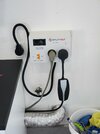Jeremy3292
Active Member
There a few good reasons why hardwired chargers are safer and why the NEC is specifically concerned with EV outlet charging and does not really care about hard wired EV charging. This is not to say that a properly installed 14-50 outlet is unsafe, but most readily available 14-50 outlets were not designed for EV charging. A stove pulls ~30 amps for an hour or two, infrequently, and is rarely ever unplugged from the outlet. An EV pulls a constant 30+ amps for a long period of time, is frequently used, and is plugged/unplugged relatively often (unless you have 2 mobile chargers). You really would want a heavy duty industrial grade 14-50 outlet like Hubbell brand and those are ~$75 and generally have to be ordered online. The constant plugging/unplugging and constant power draw wears down (melts) those 14-50 outlets you find at your local home improvement store as they are $10 and designed for an oven/stove. There are sooooo many threads on here about burned out/melted 14-50 outlets because of everything mentioned previously. But it isn't a sure thing it will happen to you, it's just why install a new outlet when the Tesla Wall Connector is available and you can keep your mobile charger in your car for traveling? There is a reason Tesla recommends the Wall Connector and I promise you it's not bc of extra $$$ for them as they aren't making much of anything at the $500 price point (similar not Tesla brand chargers are $800+). But I wouldn't worry about your outlet burning down your house or anything drastic like that, assuming it was installed properly, it just may need replacing at some point. I personally try to get people to go the hard wired route if they haven't done it yet and do not try and bash those who have one already of course - your install looks very nice!Informative. Thank you. We had an electrician install ours. The hoops were invisible to me. Took a few hours and he was done. Works well. We live in Canada. It may be different here. Stove plugs are very common here for EV EVSE's.
Last edited:



